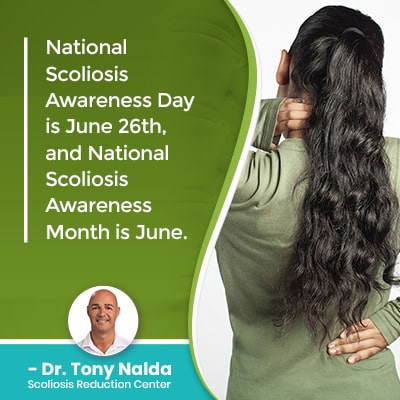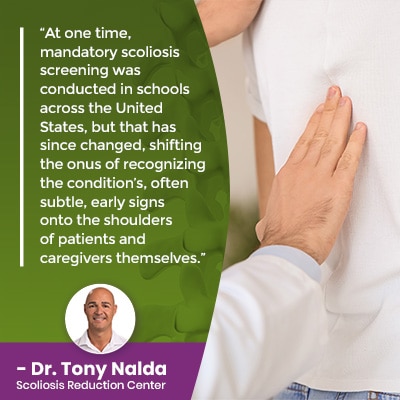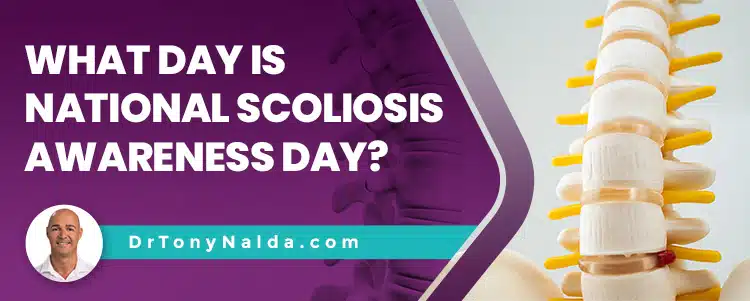Scoliosis is a complex spinal condition that deserves to be in the spotlight. When scoliosis is diagnosed early in its progressive line, if that diagnosis is met with proactive treatment, there are fewer limits to what can be achieved. National Scoliosis Awareness Day strives to increase the dialogue around scoliosis and the benefits of early detection.
June is National Scoliosis Awareness Month, and June 26th, specifically, is National Scoliosis Awareness Day. As such a highly-prevalent spinal condition, scoliosis awareness is important; it can lead to early detection and intervention, and better treatment outcomes.
Let’s discuss what National Scoliosis Awareness Day wants to achieve, and how spreading awareness can lead to early detection and treatment success.
When is National Scoliosis Day?

National Scoliosis Awareness Day is June 26th, and National Scoliosis Awareness Month is June.
Why does scoliosis need an awareness day and/or month, you might be wondering, and the answer is that as a highly-prevalent spinal condition with so many treatment benefits associated with early detection, we want more people to be able to recognize the condition’s early signs.
The Scoliosis Research Society puts current estimates at close to seven million people currently living with scoliosis in the United States alone, and as the leading spinal condition amongst school-aged children, scoliosis awareness is a necessity.

At one time, mandatory scoliosis screening was conducted in schools across the United States, but that has since changed, shifting the onus of recognizing the condition’s, often subtle, early signs onto the shoulders of patients and caregivers themselves.
And why is early detection so beneficial?
Early Detection Benefits
As a progressive condition, scoliosis has it in its nature to worsen over time, particularly if left untreated.
It ranges from mild to moderate and severe to very severe, and that is also the condition’s progressive line, so where a scoliosis is at the time of diagnosis is not indicative of where it will stay, specifically if left undetected and/or untreated.
Scoliosis is the development of an unnatural sideways spinal curve that doesn’t just bend unnaturally to the side, it also rotates (twists from front to back, back to front).
It’s the rotational component that sets scoliosis apart from many other spinal conditions that involve a loss of its healthy curves; it’s a 3-dimensional spinal condition.
It can seem difficult to imagine that an unnatural spinal curve wouldn’t be obvious from the moment it developed, but in most cases, the condition’s early signs are subtle and difficult for anyone, other than an expert trained in what to look for, to notice.
There are different types of scoliosis, but the most-prevalent form is adolescent idiopathic scoliosis (AIS), diagnosed between the ages of 10 and 18, so we’ll focus on this type for our current purposes.
The idiopathic designation means not clearly associated with a single-known cause, but just because we don’t always understand what triggers the onset of scoliosis, we most certainly understand what triggers it to progress: growth and development.
So for adolescents who are in, or are entering into, the stage of puberty, they are at risk for rapid-phase progression because of the unpredictable and rapid growth spurts associated with puberty.
Scoliosis progressing means the unnatural spinal curve is increasing in size, along with the condition’s uneven forces, and their effects.
A condition that’s detected early is going to be simpler to treat because treatment can be started early in its progressive line.
How Progression Affects the Spine
As a scoliotic spine progresses, the condition is getting more severe, and the spine is getting more rigid: making it less responsive to treatment.
In addition, there are a number of therapeutic exercises and stretches that are part of treatment, and patient’s who’ve experienced significant progression might not be able to perform them due to increasing spinal rigidity.
The uneven forces of scoliosis don’t just affect the spine, but also its surrounding muscles and nerves.
The muscles being affected by progression means the unnaturally-curved spine is pulling its surrounding muscles in different directions, and this can cause a muscle imbalance as the muscles on one side of the spine are stretched and loose from overuse, while muscles on the opposite side can become weak from underuse.
Successful scoliosis treatment minimizes the condition’s effects, and it’s far simpler to work proactively towards preventing progression and increasing condition effects while conditions are still mild, rather than working towards reversing those effects once they’ve developed.
Nerve compression can also cause a wide range of symptoms, and this brings us to another reason why early detection of adolescent idiopathic scoliosis isn’t always easy to achieve: pain.
Scoliosis doesn’t become a compressive condition until adulthood, and this is why scoliosis is not commonly painful for children and adolescents, and this is another challenge to reaching early detection.
While no one wants to experience pain, it does serve a purpose of telling us something is wrong inside the body, and in adolescent idiopathic scoliosis, the condition can go unnoticed for many years if it’s mild, isn’t causing functional deficits, isn’t painful, and postural changes can also be subtle.
Speaking of postural changes, what are the condition’s early telltale signs that patients, and parents and caregivers, should be looking out for?
Early Signs of Adolescent Idiopathic Scoliosis
While each case of scoliosis is unique, and symptoms are shaped by a number of variables such as patient age, condition type, severity, and curvature location, when it comes to AIS, the main symptom is postural deviation.
Scoliosis introduces a lot of uneven forces to the body that can disrupt its overall symmetry, and in children and adolescents, the condition’s earliest telltale signs are often uneven shoulders and hips.
Additional postural changes can include:
- The head not being centered over the torso
- Uneven shoulder blades
- The development of a rib arch
- An uneven waistline
- Arms and legs that appear to hang at different lengths
As a result of these postural changes, clothing can suddenly seem ill-fitting, and additional signs to watch for are changes to energy levels, balance, coordination, and gait.
Adolescents aren’t exactly known for transparency, so another challenge to early detection of AIS is that many young people don’t want to draw attention to themselves; they want to blend in with their peers, so even if they notice a developing body asymmetry, it’s not uncommon for them to try and hide it further, rather than bring it to the attention of parents or a family doctor, and this makes it even more important for parents and/or caregivers to be aware of the condition’s early indicators.
Conclusion
So National Scoliosis Awareness Day is June 26th, and National Scoliosis Awareness Month is June: providing an opportunity to bring scoliosis into the spotlight so potential patients, parents, and caregivers can be educated on how to achieve early detection, and why it can be so beneficial in terms of treatment efficacy.
In addition, Scoliosis Awareness Day and Month also highlights the importance of leading a spine-friendly lifestyle that’s based on movement and maintaining spinal flexibility and a wide range of motion.
Spreading scoliosis awareness is also about educating patients on the different treatment options available.
At one time, the dominant choice was traditional scoliosis treatment that funneled patients towards spinal fusion surgery, but that has since changed, and a modern conservative treatment approach that spares patients the risks associated with invasive surgical treatment has emerged.
I want patients to fully understand the pros and cons of each of the main scoliosis treatment approaches so informed decisions can be made; different treatment approaches affect the spine in different ways.
Not only do I want patients and parents to be able to recognize the condition’s early signs so early detection is possible, I also want to educate potential patients and caregivers on how a conservative treatment approach can achieve corrective results without the need for an invasive surgical procedure.
So if you have noticed a condition indicator in an adolescent, such as uneven shoulders or hips, this doesn’t automatically mean scoliosis has developed, but it does warrant the need for further testing, and when it comes to progressive conditions like scoliosis, screening tests can lead to early detection, the application of proactive treatment, and a better quality of life.
The more severe a condition becomes, the more difficult it is to treat, and the more likely it is that invasive surgical treatment will be needed in the future; this is why, here at the Scoliosis Reduction Center®, I start treatment as close to the time of diagnosis as possible when conditions are going to be more responsive and treatment success is the most likely.




